Applied Restoration came into a situation that many other contractors have faced during its tenure: When is a good time to sell and how is that process done to everyone’s satisfaction? It’s rarely an easy process, though it happens all the time in any business. The key is for all parties to walk away feeling like all had gotten a fair shake. Walls & Ceilings’ own column “Exiting Your Business” discusses this at length with specific notes and suggestions for the change-of-the-guard scenario. But in a general overview, what does it mean for new ownership?
First off, Applied Restoration was founded just 20 years ago. Mike Weinert and Jim Porter started the company in September 1998. Today, it has 16 office employees and anywhere from 50 to 70 field workers.
“Our forte is in new construction and restoration of building envelopes, as well as specialty installations of ornamental plaster, traffic coatings, polished concrete, and all types of waterproofing,” says the company’s Chief Marketing Officer Keith Simchuk.
To be more specific, the company focuses on the exterior building envelope: from below-grade waterproofing to air and water barriers, EIF systems, cement plaster (stucco) and sealants. The company’s work includes both new construction and restoration, commercial and residential. So, the name Applied Restoration is a pretty succinct and apt moniker.
In regards to areas of specialties, COO Larry White says exterior claddings is the bread and butter:
“EIFS, whether it is new installation or restoration of existing EIFS, is a large portion of our business, also waterproofing including deck and traffic coatings and sealants. As part of our restoration we include concrete spall repair, masonry repair, epoxy injection and concrete reinforcement, which helps us address compete building envelope.”
In twenty years, the company certainly has achieved its credibility, joining the likes of AWCI, whom its current COO is the chair of the EIFS Education Committee and EIFS Technical committee, a board member of the Northwest Wall and Ceiling Bureau, NW Wall & Ceiling Contractors Association, EIMA, ASTM (sitting on two committees and five subcommittees including air barriers, EIFS, lath and plaster), the Air Barrier Association of America and the AGC.
From the Beginning
Since the company was founded, Simchuk says the company started off strong.
“The company was an extremely small corporation when I got involved and has a very aggressive growth plan that will enable us to hit $20 million in the near future,” he says.
“It continues to grow and as with all companies that experience growth of the magnitude that we’re experiencing, it exposes areas where we can improve,” says Simchuk. “Business is good but we are always looking to improve and better our company as a whole.”
One of the most time-consuming tasks is to sort through all the projects that are out there and go after the ones that actually fit into the company’s wheelhouse. This is half the battle when it comes to being able to decide which projects are the most conducive for ARI to focus on, he says.
When to Buy
Key employees were interested in buying the business and it seems the founders were interested in the proposition. Well, it worked out.
“The process is very intricate and has to be a win-win (to use an overused cliché) for both parties,” says Simchuk. “It was a number of years in the making before both I and Larry were part of the buyout. There are usually four options for one who owns a business and decides to retire.”
- Find a buyer who is able to buy the business outright
- Institute some type of employee ownership/buyout
- Close the business
- Find a buyer(s) who’s willing to grow the business and accept a buyout through sweat equity:
Option 1 usually is a long shot.
Option 2 takes years to implement.
Option 3, although the easiest, doesn’t leave much of a legacy or give existing employees a fighting chance. And the owners don’t get any equity out of the business.
Option 4 takes a little bit of time to find the right individuals who are willing and able to put the time in and are willing and understand the risk involved. Those are the ones that will be able to help the original owners leave a legacy and ensure a home for those existing employees who are willing to accept change and growth.
Market Overview
The current interested parties saw that Applied Restoration was a profitable investment, and hence, were interested in the purchase. According to White, these last couple years was a time to approach the subject.
“The business saw a lot of growth early on until the downturn of 2009, then with solid recovery it plateaued and stayed consistent at $3 to $5 million annually. After Keith and I came on board, we accelerated the growth.
“Seattle and the Northwest continues to be one of the hottest markets in the country,” White says. “San Diego has been hot but has slowed a little, but we see it heating back up soon.”
Changes
When asked when is a good time to look into the purchasing of a company, Simchuk says this: “As early as possible. Most acquisitions come up at inopportune times. How many times have business owners said if they had extra cash, they’d buy that business? It happens all the time.
“If you plan from the get-go to always be in acquisition mode, then when those once-in-a-lifetime opportunities arise, you’ll have the means to make those acquisitions happen. Or at least have a fighting chance at making those acquisitions come to fruition.”
Finally, White sums up their plans for the company coming up: “This buyout is predicated on substantial growth and profitability. Making this happen demanded change, primarily we needed everyone to stop thinking like a small company and start operating like a big company.
“This has not necessarily been easy, as many employee have been with the company for a long time and most employees don’t like change,” he continues. “Being the newbies at first we had a lot of pushback but now that they really see our vision for the future they are embracing our changes.”












